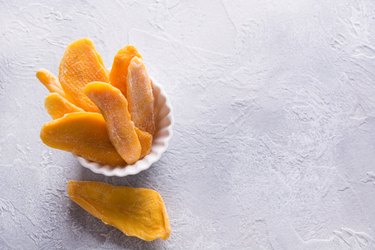
Found in both animal and vegetable fat, the most common use for glycerin in food is as a preservative. This compound is extremely versatile and can be added to many products, from beverages like soda to soaps.
Uses for Glycerin
Video of the Day
There are many names for the chemical glycerin. Glycerol is very common, but glycerin and glycerine are used too. These compounds have the same structure, meaning they're just different names for the same chemical. The substance itself is considered a sugar alcohol.
Video of the Day
You may have heard of glycerin in a different context. Glycerol is a byproduct of biodiesel production. It forms during the process of turning vegetable oils into biodiesel. According to a June 2017 study published in Membranes, producing 100 kilograms of biodiesel creates 10 kilograms of glycerol with a purity of 50 to 55 percent.
Don't let the many uses of glycerin intimidate you. There are hundreds of products containing glycerol and glycerin, from cosmetics to soaps. However, it has been labeled safe for human consumption by the Food and Drug Administration (FDA).
Glycerin is clear, colorless and odorless according to the Centers for Disease Control and Prevention. It's an ideal food additive because you won't even notice it's there. It has a low melting point at 64 degrees Fahrenheit, but a high boiling point at 554 degrees F. The low melting point makes it useful in beverages because it won't solidify as long as it's kept in the refrigerator.
Read more: The Effects of Glycerin on Skin
Glycerin in Stevia
Much of the glycerin in food is made from vegetables, making it suitable for vegetarians and vegans. Sometimes, the ingredients list will explicitly mention vegetable glycerin. For example, the first ingredient in stevia-based sweeteners is vegetable glycerin.
Stevia sweeteners are made from the plant with the same name. These sugar substitutes have zero calories and zero carbs, so they don't affect blood sugar levels. Using stevia can make it easier to eliminate or cut back on table sugar. This non-caloric sweetener is so potent that you only need a little to recreate the taste of sugar in a dish.
You can use stevia in coffee, tea or baked goods that require sugar. It's safe to consume, according to the Food and Drug Administration. Using stevia leaves as a replacement for table sugar was shown to decrease blood glucose levels in people with type II diabetes, according to an April 2015 study published in the Journal of Medicinal Plant and Herbal Therapy Research.
Read more: The Most Common Food Preservatives
Uses of Glycerin in Food
Glycerin is used in dried fruits, such as mangos. In dried mangos, it's listed as the third ingredient right after sugar (depending on the brand). Besides food products, beverages like Flynn's Soda Shop Root Beer may contain glycerin too.
When added to beverages like soft drinks and sports drinks, glycerin helps create a smooth texture. According to an article from the USDA, this compound is also used as a carrier of flavors in beverages. Since it helps retain the flavor in liquids, it's also used in products like vanilla extract and chocolate syrup.
Soft drinks like Coca-Cola and sports drinks like Gatorade are rich in sugar. These beverages might give you a temporary energy boost, but they are unhealthy in the long-term. An August 2018 research paper published in Annual Reviews has found that drinking sugary beverages may increase the risk of developing cancer by 23 to 200 percent. Therefore, stevia-sweetened beverages might be a better option.
- Annual Reviews: "Consumption of Sugars, Sugary Foods, and Sugary Beverages in Relation to Cancer Risk: A Systematic Review of Longitudinal Studies"
- United States Department of Agriculture: "Glycerin"
- USDA: "Flynn's Soda Shop, Soda Mix, Root Beer"
- USDA: "Dried Mangos"
- U.S. Food and Drug Administration: "Has Stevia Been Approved by FDA to Be Used as a Sweetener?"
- United States Department of Agriculture: "Stevia Sweetener"
- Centers for Disease Control and Prevention: "Glycerin (Mist)"
- U.S. Food and Drug Administration: "Title 21-Food and Drugs Chapter I--Food and Drug Administration Department of Health and Human Services Subchapter B--Food for Human Consumption (Continued)"
- Membranes: "Glycerol Production and Transformation: A Critical Review with Particular Emphasis on Glycerol Reforming Reaction for Producing Hydrogen in Conventional and Membrane Reactors"
- American Chemistry Council: "Glycerol"
- Journal of Medicinal Plant and Herbal Therapy Research: "Effectiveness and Safety of Stevia Rebaudiana Dried Leaves as an Adjuvant in the Short-Term Treatment of Type 2 Diabetes: A Randomized, Controlled, Cross-Over and Double-Blinded Trial"